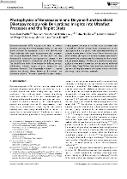Photophysics of Benzoxazole and Dicyano Functionalised Diketopyrrolopyrrole Derivatives: Insights into Ultrafast Processes and the Triplet State

Author
Panthi, Yadu Ram
Thottappali, Muhammed Arshad
Horáková, Petra
Kubáč, Lubomír
Pfleger, Jiří
Menšík, Miroslav
Khan, Tuhin
Publication date
2024Published in
Chemphyschem : a European journal of chemical physics and physical chemistryVolume / Issue
25 (13)ISBN / ISSN
ISSN: 1439-4235ISBN / ISSN
eISSN: 1439-7641Metadata
Show full item recordCollections
This publication has a published version with DOI 10.1002/cphc.202300872
Abstract
Diketopyrrolopyrrole (DPP) functionalised with an electron donating unit acts as a donor-acceptor molecules that have shown potential for application in dyes and photovoltaics. These molecules offer broad absorption/emission properties and structure-dependent dynamics. In this study, we used femtosecond pump-probe spectroscopy to investigate the photo-initiated dynamics of thiophene linked DPP derivatives. The thio-DPPs are further functionalised by different electrons withdrawing terminal groups, namely benzoxazole and thiophene dicyanide. The benzoxazole derivative is strongly emissive and directly relaxes directly to the ground state chloroform solution. Thiophene dicyanide derivative exhibits distinct spectral evolution in the first 10 ps, associated with structural and vibronic process. Later, it crosses over to the triplet state with a yield of 20%. In the solid-state (thin film), we observed a signal that resembles singlet fission. However, upon careful analysis of temperature-dependent steady state absorbance spectra, we conclude that these features are due to laser-induced thermal artifacts. We describe a simplified excited state evolution in the thin film that does not include any additional excited states. These findings have significant implications for the analysis of triplet formation, which plays a major role in the photophysics of many organic materials.
Keywords
diketopyrrolopyrrole, fluorescence, photophysics, singlet fission, time-resolved spectroscopy, triplet
Permanent link
https://hdl.handle.net/20.500.14178/2981License
Full text of this result is licensed under: Creative Commons Uveďte původ 4.0 International




